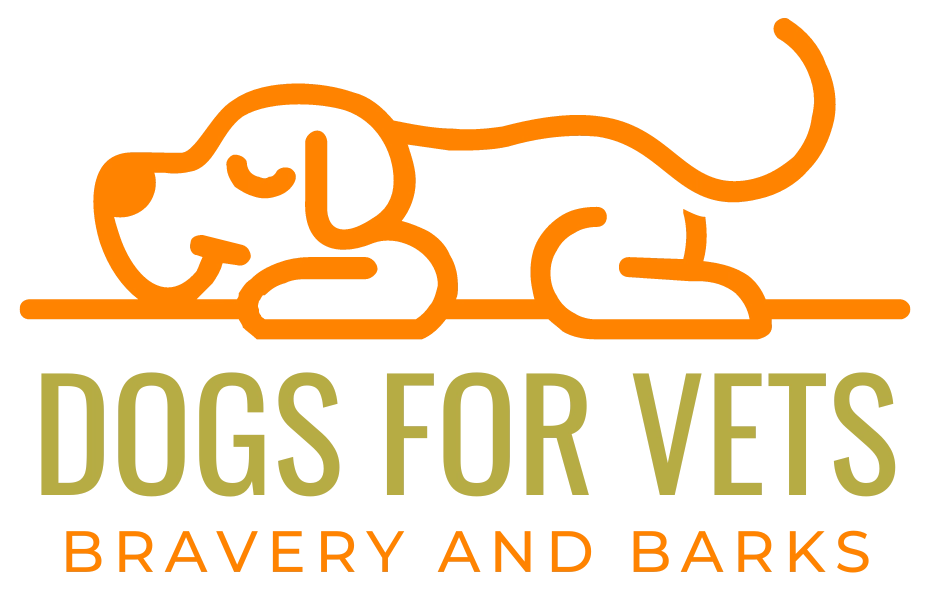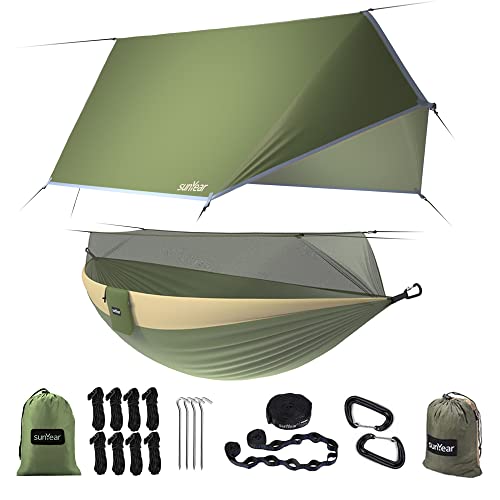This post may contain ads and affiliate links and we may earn a small commission when you click on the links at no additional cost to you. As an Amazon Affiliate, we earn from qualifying purchases. You can read our full disclaimer here.
Hammock Camping with Dogs: The Must-Read Before You Pack

Hammock camping with dogs offers a unique blend of relaxation and bond-building with your dog.
Camping is a great way to unwind and connect with nature. Bringing your dog along can make the experience even more rewarding.
Imagine waking up to the sun gently rising over a serene landscape, with your loyal companion by your side.
It’s a lightweight, fun alternative to traditional tent camping. With the right preparation, your dog can enjoy swinging between the trees with you.
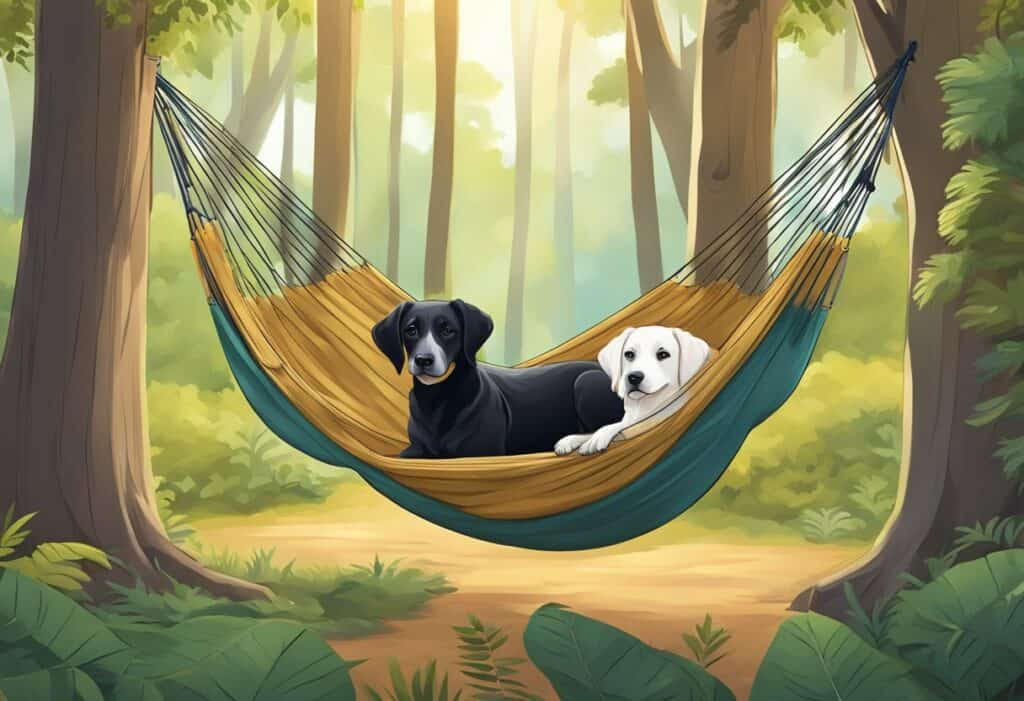
Before you venture into the great outdoors with your furry friend, there are a few things to consider ensuring the trip is comfortable and safe for both of you.
You’ll need to get your dog acquainted with a hammock, practice Leave No Trace principles, and pack appropriate gear for your canine companion.
Understanding your dog’s needs and preparing for various outdoor scenarios will set the stage for an unforgettable hammock camping adventure.
Benefits of Hammock Camping with Dogs
When you bring your furry friend along on a hammock camping trip, you’re in for a unique experience that’s both relaxing and rewarding. Let’s check out the benefits:
Elevated Rest: Your dog can sleep above ground, away from dampness, bugs, and potentially uneven terrain. This means a more comfortable and secure rest for your buddy.
Bonding Time: Sharing a hammock enhances the bond between you and your dog through close proximity and shared experiences in nature.
Closer to Nature: In a hammock, you’re both suspended in the great outdoors, providing a unique vantage point to enjoy the surroundings. It’s a calm environment, which can be very soothing for you and your dog.
Ease of Setup: Modern hammocks are lightweight and quick to set up, meaning less hassle for you and more downtime with your pet. Here’s a simple breakdown:
| Step | Benefit |
|---|---|
| Unpack | Quick and easy |
| Attach straps | No complicated knots required |
| Adjust | Find the perfect height |
Portability: With a hammock, you can camp in spots where traditional tents might not fit, giving you and your dog access to unique locations.
Remember, safety first! Make sure you choose a dog-friendly hammock, assess your dog’s comfort with the setup, and never leave them unattended.
Choosing the Right Hammock
When hammock camping with your dog, it’s essential to pick a hammock that will hold both your weight and your pet’s comfortably, made from durable materials for rough use, and ensure both your and your pet’s safety and comfort.
Size and Strength Requirements for Hammock Camping with Dogs
When planning a hammock camping trip with your furry friend, considering the size and strength of your gear is crucial.
You want to be sure that both you and your dog can relax safely and comfortably.
Here’s a straightforward guide to help you out:
- Hammock Weight Capacity: Choose a hammock with a weight capacity that can support both you and your dog comfortably. A good rule of thumb is to pick one that can handle at least 150 lbs more than your combined weight.
- Durable Material: Look for hammocks made from high-density, durable fabrics like parachute nylon or polyester. These materials are not only strong but also more resistant to your dog’s claws.
- Tree Strap Strength: Don’t overlook the strength of your tree straps. Ensure they can support the combined weight and are wide enough to protect the trees.
- Proper Anchoring: Secure the hammock with solid, reliable knots or carabiners. Double-check that everything is properly anchored before hopping in.
- Space for Two: Make sure the hammock is spacious enough to accommodate both you and your pup. A double hammock usually offers ample space and comfort.
Perfect for hammock camping with dogs, this lightweight hammock provides ample space for relaxation. Crafted from premium materials for durability, it’s the ultimate outdoor resting spot for you and your canine companion. A must-have for every dog-loving adventurer.
Material and Durability: Key Considerations for Hammock Camping with Dogs
The material and durability of the hammock are paramount. You need something that will withstand the test of nature and the added challenge of canine claws and movement.
Opt for materials that are tear-resistant and can handle the wear and tear of outdoor adventures.
A durable hammock ensures a safe and comfortable rest for you and your pet, preventing any unexpected accidents or damage.
| Feature | Ideal Material | Benefits |
|---|---|---|
| Fabric Strength | High-Denier Nylon or Polyester | Resists tearing and can handle more weight and stress. |
| Claw Resistance | Ripstop Nylon | Prevents small tears from widening, offering better protection against sharp claws. |
| Weather Resistance | Waterproof Coated Fabrics | Keeps you dry and comfortable, ideal for various weather conditions. |
| Stretch | Low-Stretch Fabrics | Provides more stability and less sagging, ensuring your dog doesn’t roll on top of you. |
| Maintenance | Machine Washable | Easy to clean after outdoor adventures with your pet. |
The package comes fully equipped with two easy-setup straps featuring 32 adjustment loops and a combined length of 20 feet, alongside two ultra-strong 12KN carabiners and net ropes. This means no extra expenses or time wasted – you’re ready to hang between the trees in moments.
Comfort and Dog Safety: Happy Hammock Adventures
Hammock camping with your pet is both fun and rewarding. With the right approach, any outdoor spot can become a peaceful retreat for you and your companion.
Here’s how to make your hammock session both pleasant and safe:
- Select the Ideal Hammock: Opt for a deep, soft, breathable fabric to ensure comfort and stability for you and your pet.
- Hammock Introduction: Help your dog get used to the hammock by practicing at home, letting them adapt to its movement in a familiar environment.
- Check Your Equipment: Inspect the hammock, straps, and carabiners regularly for any signs of wear or damage.
- Always Watch Your Dog: Keep a close eye on your pet when they’re using the hammock to avoid any possible accidents.
- Harness for Safety: A safety harness might be necessary for active dogs to prevent falls.
- Provide a Personal Space: Bring along a separate bed or blanket specifically for your dog to make the hammock feel welcoming.
- Accessible Water: Place water within easy reach to keep your dog hydrated during your trip.
- Guard Against the Elements: Protect your pet from extreme weather conditions while they are in the hammock.
- Secure the Area: Ensure the hammock surroundings are free from potential hazards or sharp objects.
- Teach Safe Entry and Exit: Guide your dog on how to get into and out of the hammock safely to prevent injuries.
- Double Padding: Add an extra layer of padding in the hammock to prevent any tears from your dog’s claws and ensure added comfort for both of you.
By incorporating these tips, you’ll create a safer and more enjoyable environment, turning your hammock camping trip into a delightful escape for both you and your dog.
Training Your Dog for Hammock Camping
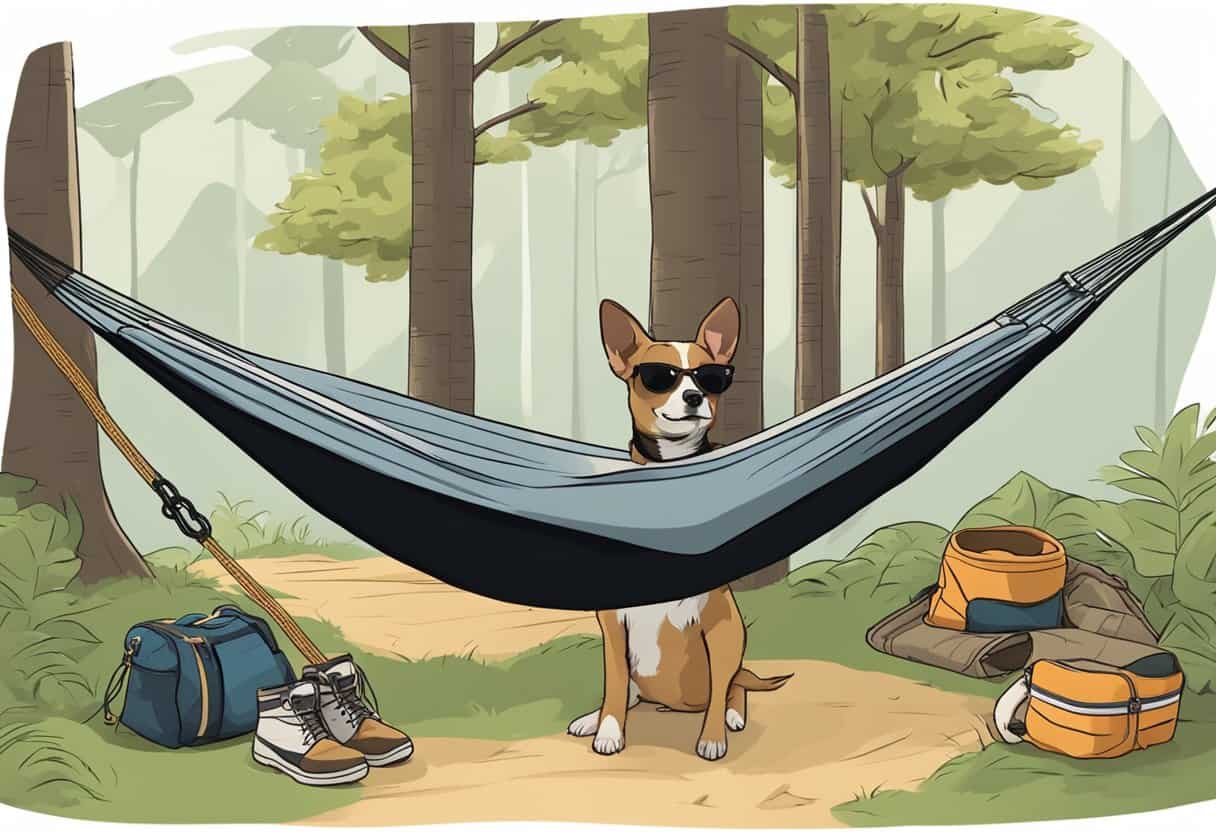
Before you hit the trails and pitch your hammock, it’s critical to ensure your canine companion is well-prepared for this unique outdoor adventure.
Familiarization with the Hammock
To start, you’ll want to slowly introduce your dog to the hammock in a calm, familiar environment.
- Begin by setting up the hammock at home, perhaps in your backyard, where your dog feels secure.
- Let your dog inspect the hammock. Allow them to sniff and explore it on their terms.
- Associate the hammock with positive experiences. Use treats and their favorite toys to make the hammock an enjoyable place.
- Gradually encourage them to join you. Sit in the hammock and invite your dog in gently, using a treat as a reward.
Stay patient; this could take a few tries over several days. Consistency is key to helping your dog become comfortable with the new experience.
Basic Commands and Behavior Training
Next, ensure your dog has a solid foundation in basic commands, as these are crucial for a safe and enjoyable hammock camping trip.
- Sit and Stay: Essential for getting into and out of the hammock without causing it to unbalance.
- Leave it: Important if your dog becomes curious about wildlife or unfamiliar items during the trip.
- Down or Off: Useful to prevent or correct any jumping on the hammock that could lead to damage or injury.
| Command | Use Case | Training Tip |
|---|---|---|
| Sit | Before getting into the hammock | Reward sitting calmly before entering the hammock |
| Stay | When in the hammock | Practice increasing duration of stay over time |
| Leave it | If they grab something unsafe | Train with different objects, reward when obeyed |
| Down | To lie down in the hammock | Use treats to encourage lying down gently |
Keep training sessions short and positive, focusing on praise and affection to reinforce good behavior.
Remember, successful hammock camping with your dog hinges on patience, training, and plenty of treats.
Preparation and Packing List
When you’re planning to hammock camp with your dog, it’s important to pack the right gear to ensure the comfort and safety of your furry friend.
Your dog’s camping needs are just as important as your own, so don’t forget to prepare accordingly.
Essential Gear for Dogs: Hammock Camping Must-Haves
Hammock camping with your dog isn’t just about finding the right hammock; it’s also about packing the right gear for your four-legged friend.
Making sure they have everything they need will make the trip more enjoyable for both of you.
Here’s a list of dog-specific gear to bring along:
- Dog Harness and Leash: A sturdy harness and leash are vital, especially in unfamiliar terrain. They keep your dog secure and under control during walks or if they become anxious.
- Portable Water Bowl: Hydration is key. A collapsible water bowl is lightweight and easy to pack, ensuring your dog stays hydrated throughout the trip.
- Dog Food and Treats: Pack enough food for the entire trip, plus a little extra, and don’t forget their favorite treats. A familiar diet helps prevent digestive issues while away from home.
- Sleeping Pad or Blanket: Even if your dog will sleep in the hammock with you, having their own pad or blanket can provide extra comfort and warmth, and protect the hammock from claws.
- First-Aid Kit: Prepare a dog-specific first-aid kit. Include items like bandages, antiseptic wipes, tick removal tools, and any medications your dog may need.
- Waste Bags: Always clean up after your dog to keep the camping area pristine and minimize environmental impact.
- Light-Up Collar or Clip-On Light: These are essential for keeping your dog visible and safe at night, especially in wooded areas.
- Extra Towels: Useful for drying your dog if they get wet, cleaning dirty paws, or providing additional warmth.
- Chew Toys or Comfort Items: Bring a few of your dog’s favorite toys or a comfort item like an old shirt that smells like home to help them feel secure.
- Protective Gear: Depending on the season and location, your dog may need additional gear like booties for rocky terrain or a coat for colder weather.
Dog-Friendly Bug Protection: Keeping Your Canine Comfy
When venturing into the great outdoors for some hammock camping, it’s not just the scenic views you’ll encounter; bugs can be a real nuisance, especially for your furry friend.
Protecting your dog from pests like mosquitoes, ticks, and fleas is crucial for their comfort and health. Here’s how to keep those pesky bugs at bay:
First and foremost, consult with your vet before any trip to ensure your dog is up to date on flea and tick prevention and to discuss any additional measures you should take.
Then, pack the right kind of dog-friendly bug protection to keep your pet happy and itch-free.
Here’s a table detailing various dog-friendly bug protection methods and products:
| Protection Method | Product Type | Usage Tips |
|---|---|---|
| Topical Treatments | Flea and Tick Spot-Ons | Apply directly to your dog’s skin as instructed; make sure it’s dry before cuddling in the hammock. |
| Oral Medications | Flea and Tick Pills | Administer as directed by your vet; this is usually a monthly treatment. |
| Insect Repellent Gear | Collars, Bandanas, or Apparel | Choose items treated with insect-repellent chemicals or natural oils safe for dogs. |
| Natural Solutions | Essential Oil Sprays (e.g., Lemon Eucalyptus) | Use products specifically designed for dogs; never use human insect repellent on your pet. |
| Environmental Controls | Portable Dog Beds, Mesh Tents | Provide a bug-proof zone with items like elevated beds or dog tents. |
| Regular Grooming | Combs and Shampoos | Use flea combs and special shampoos to physically remove pests and soothe bug bites. |
Remember, the best approach combines several methods to ensure your dog is fully protected.
Always double-check that any product or method is safe for use around dogs, as certain chemicals and essential oils can be harmful to them.
With the right preparations, you and your dog can enjoy a bug-free hammock camping experience.
Managing Food and Water for Your Dog
When hammock camping with your furry friend, it’s crucial to keep them well-fed and hydrated. Here’s the best way to ensure they stay happy and healthy during your outdoor adventure:
Food Essentials
Bring along your dog’s regular food to avoid any upset stomachs. Pack enough for the whole trip, plus a bit extra, just in case.
Use lightweight, resealable bags for convenience and freshness. A portable, collapsible bowl will make meal times easy and mess-free.
Water Necessities
Water is just as important for your dog as it is for you, especially outdoors. Carry enough for both of you and consider using a collapsible bowl for your dog’s drinks.
If you’re using natural water sources, remember to purify the water before letting your dog drink.
Snacks and Treats
Don’t forget to pack some of your dog’s favorite snacks.
They’re great for keeping energy levels up and reinforcing good behavior on the trail.
Storage Solutions
Keep your dog’s food dry and safe by storing it in airtight containers.
If you’re in bear country, use bear-proof storage or hang food supplies away from your campsite.
Feeding Schedule
Try to stick to your pet’s usual feeding routine to help them feel more at home in the great outdoors. Regular meals help maintain energy levels and digestion.
Hydration Checks
Keep an eye out for signs of dehydration in your dog, such as excessive panting or dry gums, and make sure they drink regularly throughout the day.
By properly managing your dog’s food and water, you ensure a more enjoyable and stress-free camping experience for both of you.
Setting Up Camp
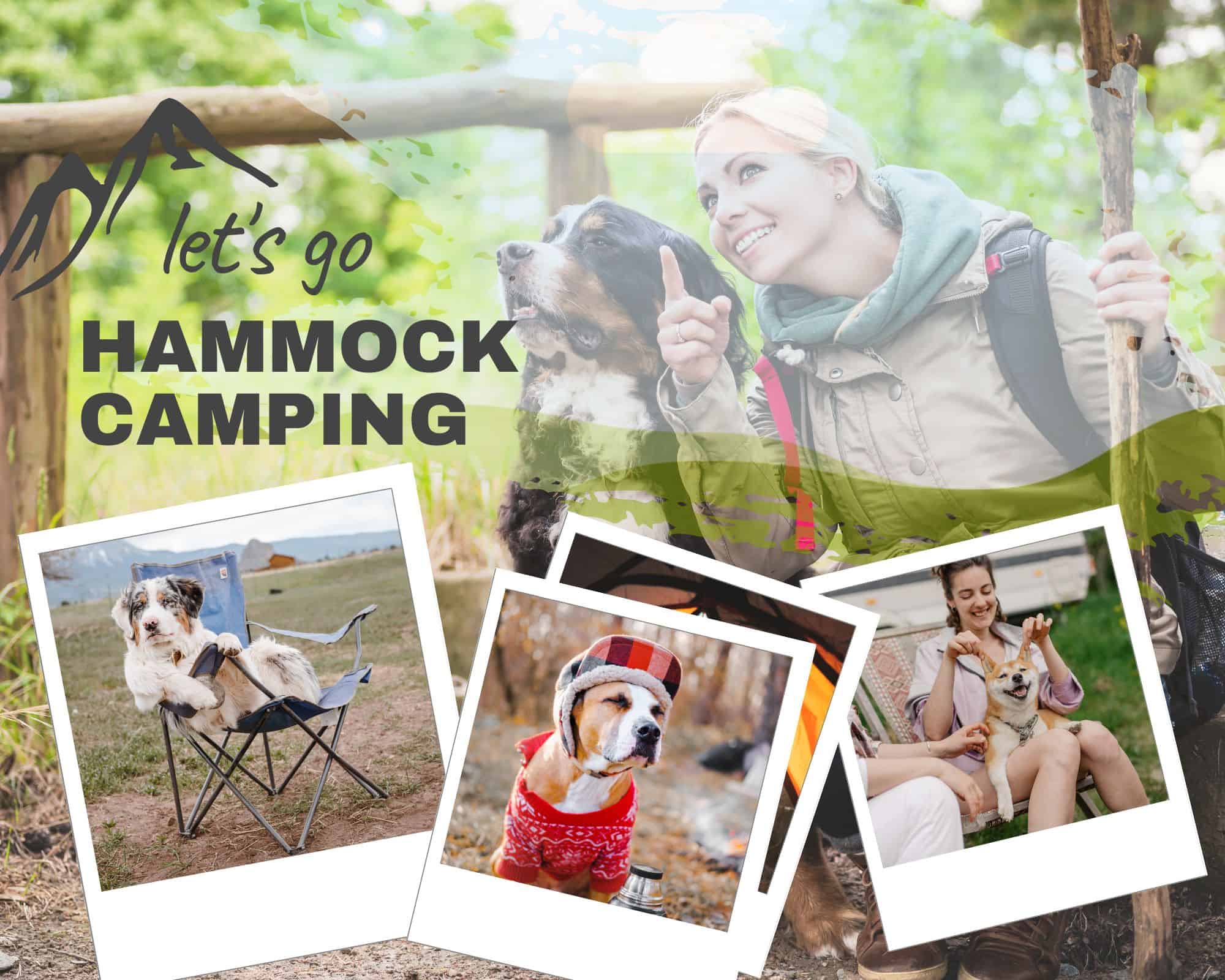
When you’re hammock camping with your dog, it’s essential to find the right spot for your hammock, ensure a secure setup, and make a safe area for your dog to rest.
Selecting a Location
- Trees: Look for two sturdy trees about 12 to 15 feet apart. They should have no signs of disease or instability.
- Underbrush: Avoid areas with dense underbrush. This reduces the risk of your dog encountering pests like ticks.
- Ground Conditions: Opt for high ground to prevent flooding and ensure good drainage. A flat area underneath makes it safer for your dog.
- Consideration for Others: If in a shared campsite, set up away from walking paths to minimize disturbances.
Hammock Setup Tips
- Straps: Use tree-friendly straps at least 0.75 inches wide to avoid damaging the bark.
- Height: Position your hammock so the lowest point is no more than 18 inches above ground level to prevent injuries from accidental falls.
- Angle: Aim for a 30-degree angle from the strap to the tree to achieve the ideal sag for sleeping comfort.
- Gear Access: Keep a small bag with essentials like a flashlight and water bottle attached to the hammock within easy reach during the night.
Creating a Dog-Safe Area
- Bedding: Place a comfortable, insulated dog bed beneath the hammock for your pet to sleep on.
- Boundary: Set up a lightweight portable fence or use a long lead to define your dog’s area.
- Safety Check: Remove any sharp sticks or hazardous objects from the area where your dog will be lounging.
- Visibility: Keep your dog’s area within your sightline for easy monitoring.
Leave No Trace Principles
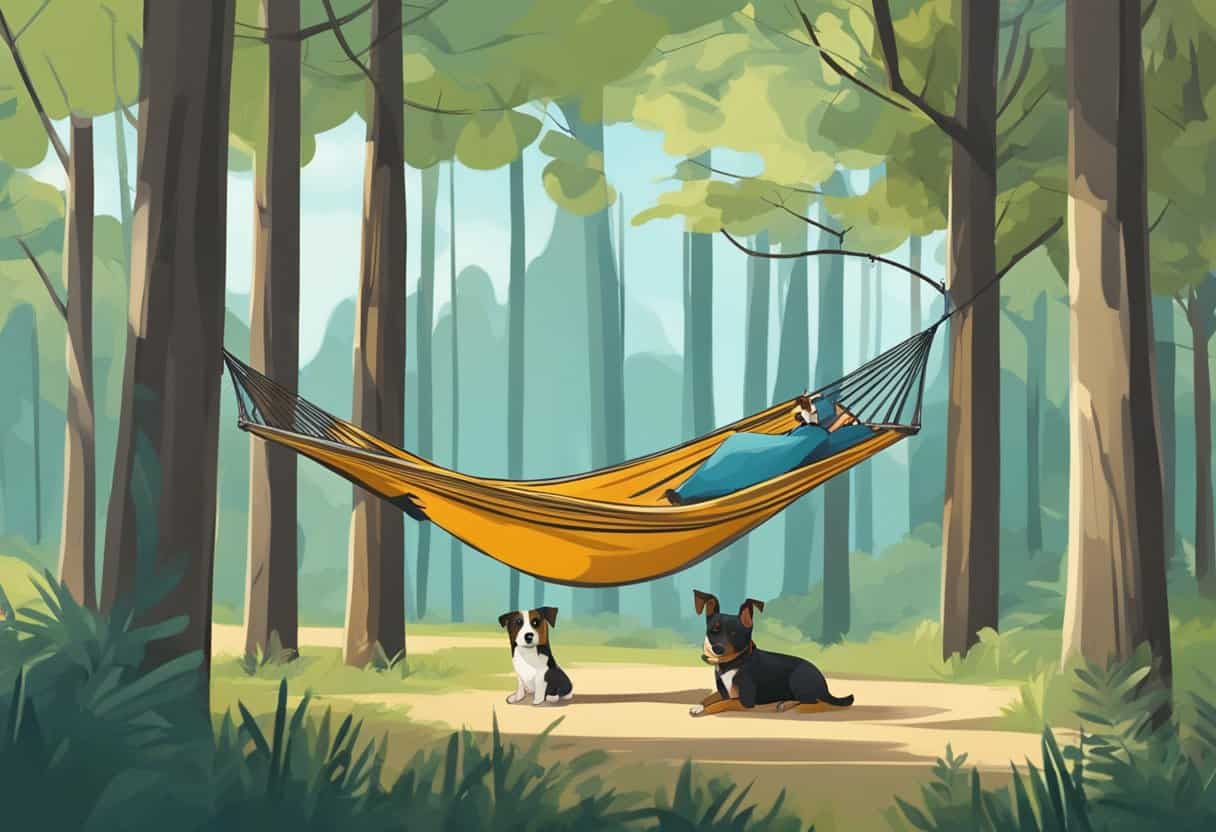
When you’re hammock camping with your dog, it’s crucial to follow Leave No Trace Principles to ensure you preserve the natural beauty of your camping environment for others to enjoy.
These guidelines help minimize your impact and maintain the wilderness.
Waste Management
- Pack it in, Pack it out: Make sure to carry bags for your dog’s waste and remove it from the site. Don’t leave it behind or bury it.
- Waste Disposal: If you’re staying for more than a day, bring airtight containers to store your dog’s waste until it can be disposed of properly.
Minimizing Impact on Surroundings
- Choosing the Right Spot: Set up your hammock and let your dog rest in durable areas where the vegetation is unlikely to be damaged.
- Respecting Wildlife: Keep your dog on a leash to prevent them from chasing or disturbing wildlife.
Seasonal Considerations
Understanding how the different seasons affect your hammock camping experience with your dog is crucial for safety and comfort.
Cold Weather Camping
When temperatures drop, insulation is key. You’ll need an underquilt for your hammock to prevent heat loss, and your dog should have an insulated sleeping pad. Check the temperature rating of your gear to ensure it matches the forecast.
Insulation Items:
- Underquilt (for you)
- Insulated sleeping pad (for your dog)
- Sleeping bags rated for the season’s lowest temperatures
Ensure your dog has a warm blanket or a dog-specific sleeping bag. Always monitor your dog for signs of discomfort or hypothermia.
Warm Weather Precautions for Your Dog
Camping in warm weather can be a fantastic experience, but it’s essential to keep your dog cool and comfortable. Here are some key precautions to ensure your furry friend stays safe under the sun:
Shade and Rest
Make sure your dog has access to shade, especially during the hottest parts of the day. Encourage regular rest breaks to prevent overheating.
Hydration
Always have plenty of fresh, cool water available. Encourage your dog to drink regularly to stay hydrated.
Cooling Gear
Consider bringing cooling mats, vests, or bandanas designed for dogs. These can help keep your pet’s body temperature down.
Paw Protection
Hot surfaces can harm your dog’s paws. Protect them with booties or avoid walking on hot ground during peak temperatures.
Heatstroke Awareness
Know the signs of heatstroke in dogs, which include heavy panting, drooling, rapid heartbeat, and lethargy. Act quickly if you notice these symptoms.
By taking these precautions, you can help ensure that your dog enjoys the warm weather safely and comfortably.
Camping Etiquette with Dogs
Bringing your dog along on a camping trip can enhance the experience, but it’s important to practice good camping etiquette so both your furry friend and fellow campers have a pleasant time.
Being considerate of others and the environment helps maintain a harmonious outdoor experience for everyone.
When camping with your dog, always keep them under control, whether through verbal commands, a leash, or a secure enclosure.
This prevents them from disturbing wildlife or other campers.
Additionally, always clean up after your dog and dispose of waste properly to keep the camping area clean and reduce the risk of contamination.
| Aspect | Etiquette Tips |
|---|---|
| Leash Requirements | Keep your dog on a leash unless in a designated off-leash area. |
| Noise Control | Prevent excessive barking to avoid disturbing wildlife and fellow campers. |
| Waste Disposal | Always clean up after your dog and dispose of waste in designated areas. |
| Wildlife Interactions | Prevent your dog from chasing or disturbing wildlife. |
| Campsite Boundaries | Keep your dog within your campsite area to respect others’ space. |
| Food Storage | Store your dog’s food securely to avoid attracting wildlife. |
| Trail Rules | Follow the specific rules of the trail, such as leash lengths and allowed areas. |
| Consideration for Others | Be mindful of fellow campers who may be afraid of or allergic to dogs. |
| Health and Vaccinations | Ensure your dog is healthy and vaccinations are up to date before the trip. |
| Nighttime Safety | Keep your dog inside your tent or hammock at night for safety and to avoid nighttime disturbances. |
Frequently Asked Questions
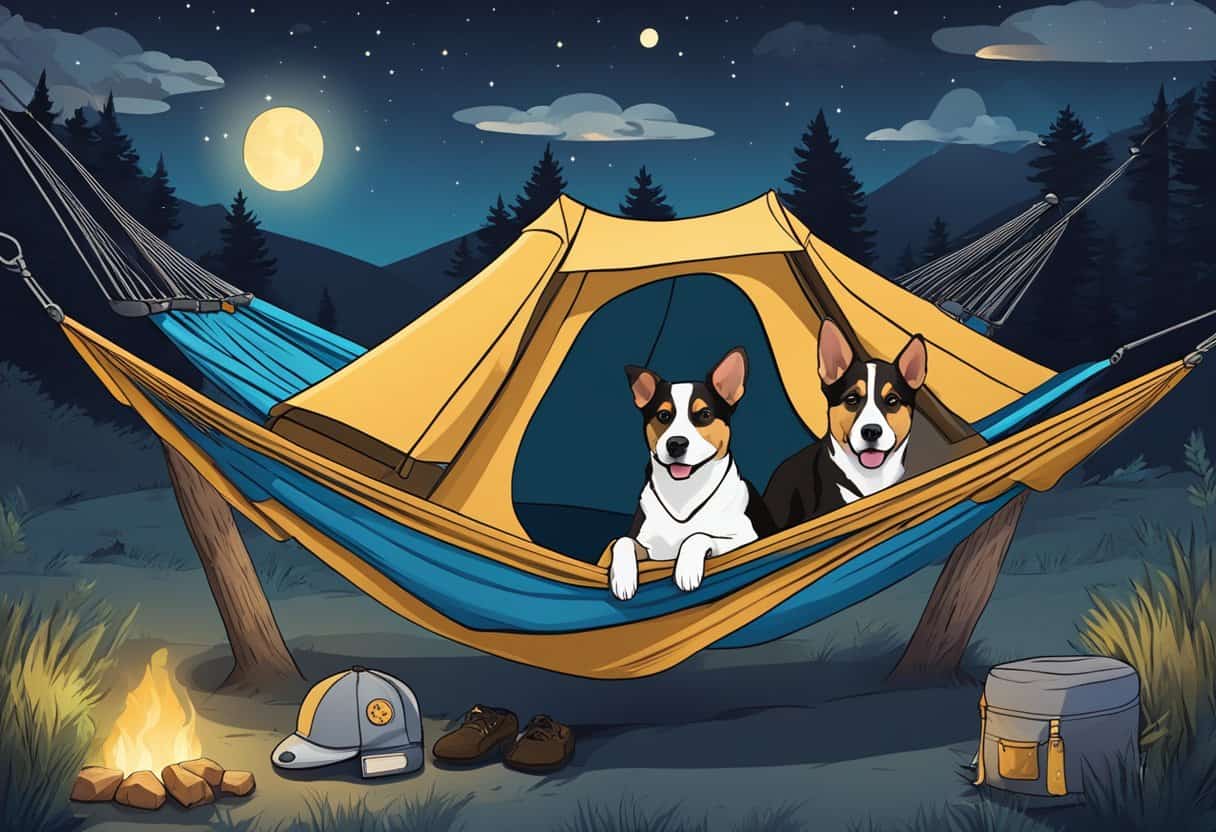
Jumping into hammock camping with your furry friend can raise a few questions. These FAQs aim to tackle issues around safety, comfort, and acclimatizing dogs to hammock camping.
How do you keep a dog secure when hammock camping?
To keep your dog secure, always use a harness with a leash that can be easily anchored to the ground or your hammock setup. Consider a dog-specific sleeping arrangement nearby so they stay put through the night.
What’s the best way to introduce a dog to hammock camping?
Start by letting your dog explore the hammock at home. Gradually increase the time they spend in it while providing treats and positive reinforcement to create a sense of safety and comfort.
Are there special hammocks made to accommodate a pet?
Yes, there are hammocks designed with extra space and durable materials to accommodate pets. Some even include attached pockets for your dog to snuggle up in securely.
How can you ensure a dog’s comfort while hammock camping?
Ensure the hammock has a stable and gentle sway. Provide a familiar blanket or toy, and make sure that your dog can get in and out easily if they need to stretch or go for a walk.
What are the safety precautions for hammock camping with dogs in wildlife areas?
Always keep your dog on a leash, be aware of local wildlife, and follow the guidelines of the area. Keep food secured to avoid attracting animals, and have a first-aid kit handy.
Can a dog’s hammock bed attach to a camping hammock?
Some hammocks have the option of an attachable dog bed beneath the main sleeping area. Alternatively, you can set up dedicated dog hammocks adjacent to your hammock.
Wrapping Up Hammock Camping with Dogs
Whether you’re hanging between trees in a snug hammock or trekking the scenic trails, remember that the great outdoors is a shared space.
By following these simple guidelines, you ensure that every paw print left behind is a mark of respect and care for nature.
So pack your bags, leash up, and set off on an adventure that’s enjoyable not just for you and your dog, but for everyone and everything around you.
-

Coffee Mug – In Dog Coffees I’ve Only Had One
$11.95 – $14.95 Select options This product has multiple variants. The options may be chosen on the product page
